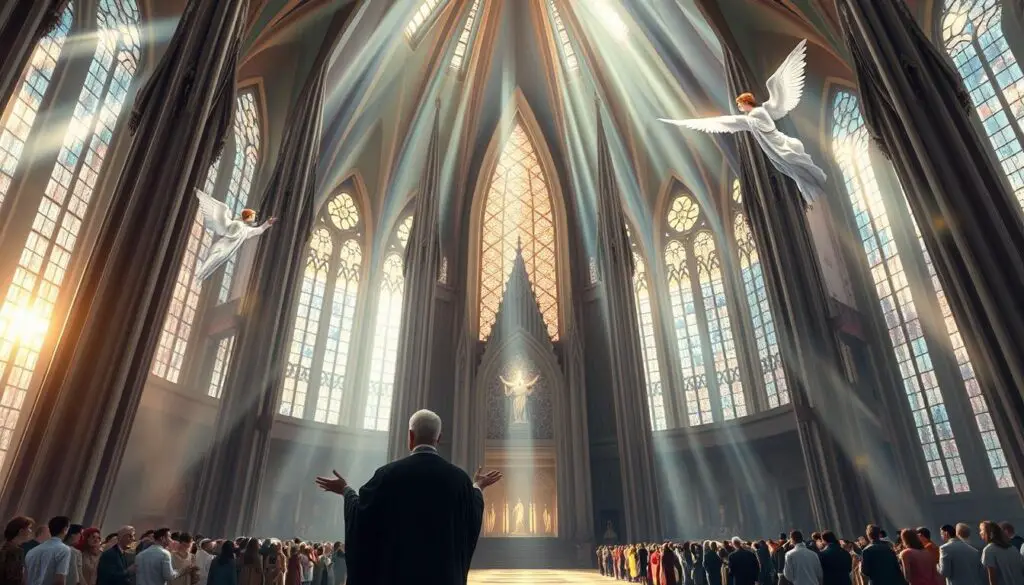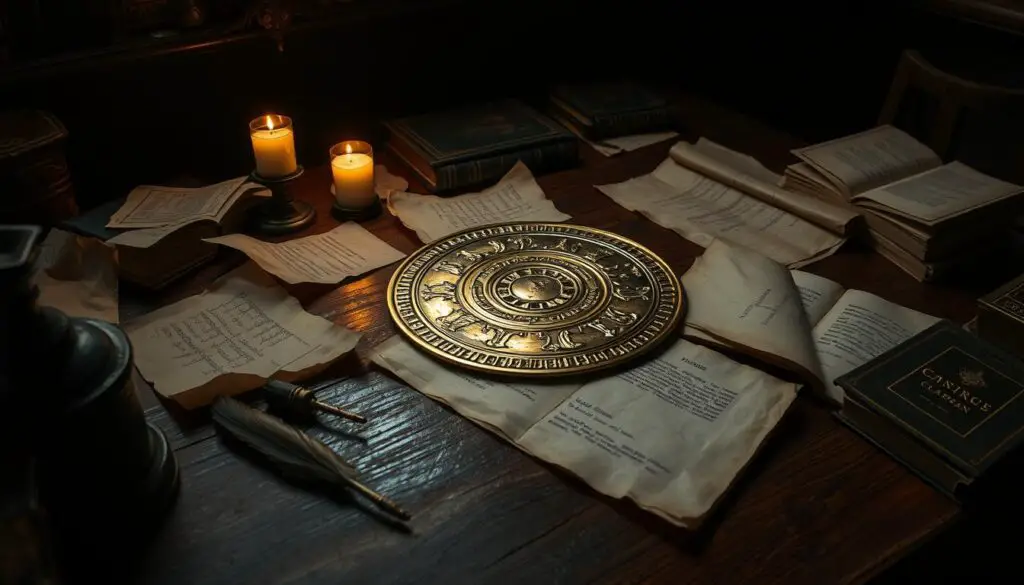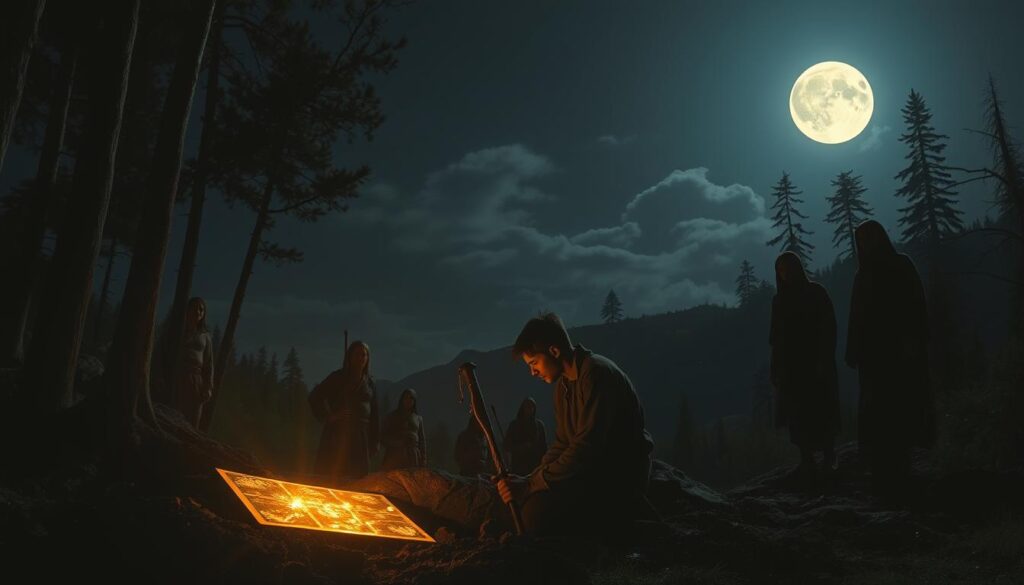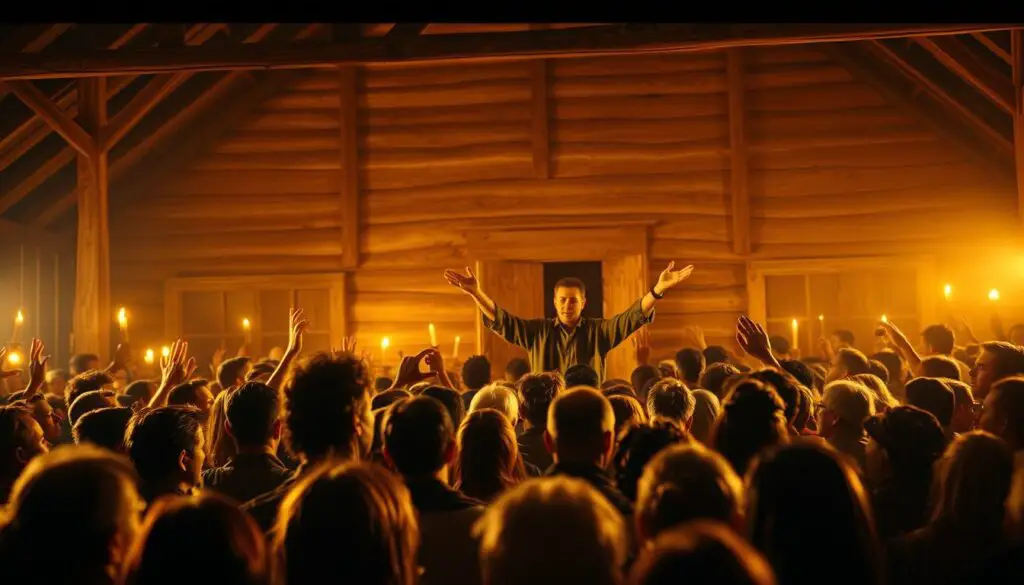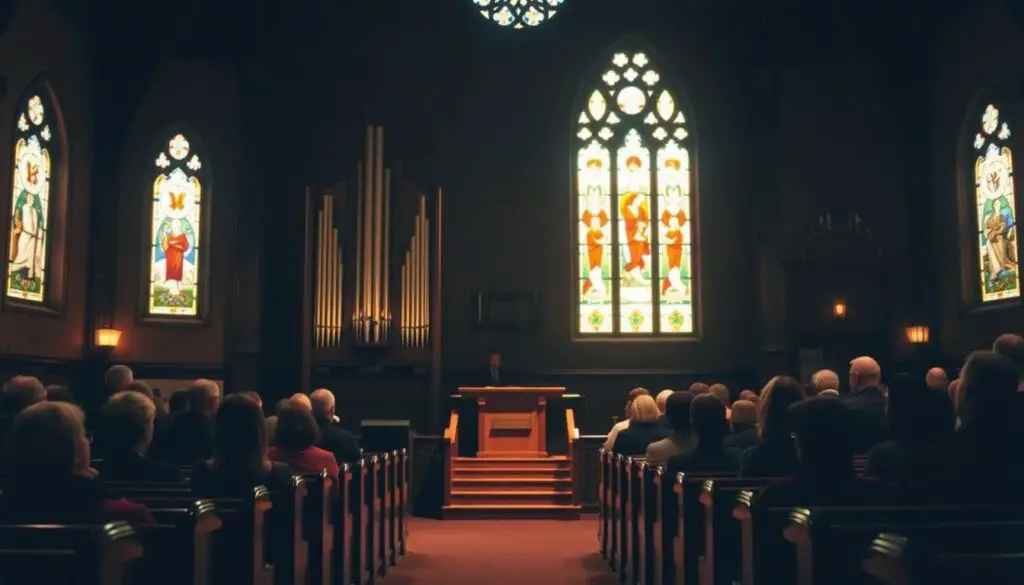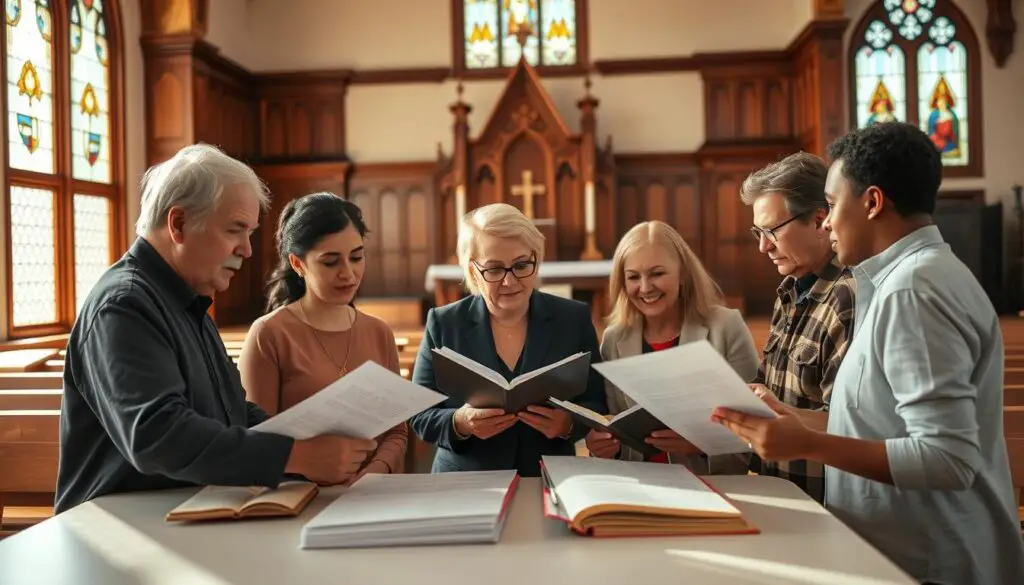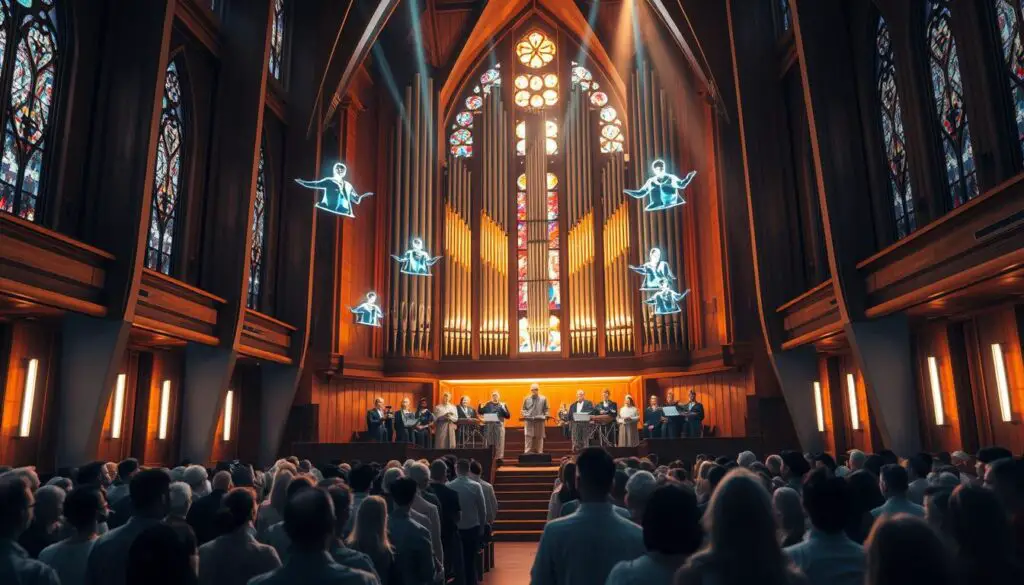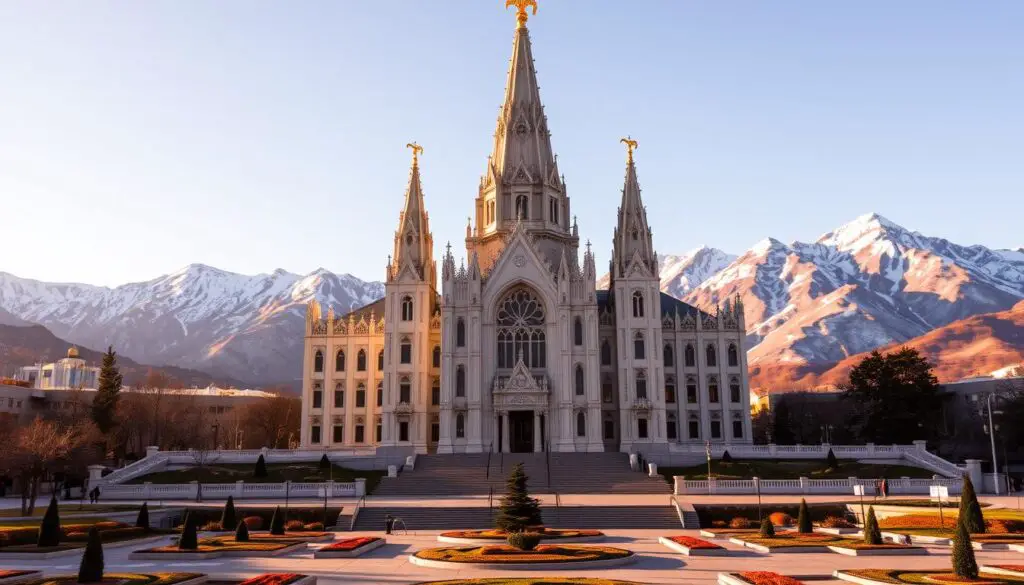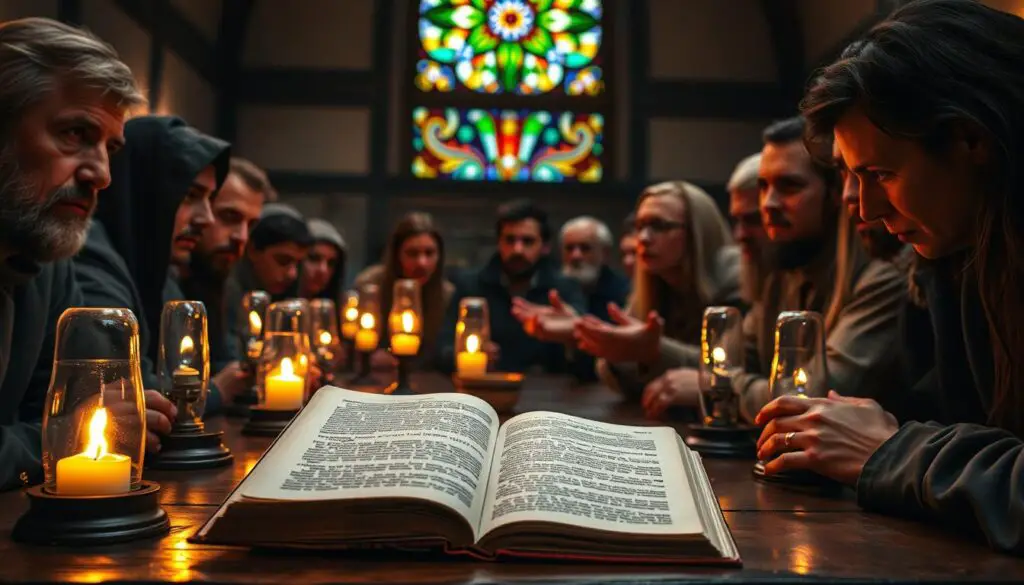Nestled in the heart of the American West lies a story of perseverance and vision. A religious group, seeking refuge from hostility, embarked on a daring journey across rugged terrain. Their destination? A land where they could freely practice their beliefs and build a society rooted in shared values.
This community’s arrival in the Salt Lake Valley marked a turning point. Through relentless effort, they transformed arid landscapes into thriving settlements. Their story isn’t just about survival—it’s about creating lasting traditions that still shape this region today.
Legal challenges and harsh climates tested their resolve. Yet, their dual focus on faith and innovation helped them thrive. Today, their legacy lives on through vibrant cultural practices and a strong sense of identity within the United States.
This article explores how early struggles forged enduring traditions. From founding principles to modern-day adaptations, we’ll uncover how this group’s pioneering spirit continues to influence life in the Mountain West.
Key Takeaways
- The region’s heritage began with a courageous migration seeking religious freedom.
- Salt Lake City became the cultural and spiritual hub for this community.
- Early settlers combined faith with practical skills to build sustainable communities.
- Legal disputes shaped the group’s relationship with the broader United States.
- Traditional values continue evolving while maintaining core principles.
Introduction to Mormon Utah History
Pioneering spirits carved a legacy from the rugged American frontier. Their story blends religious devotion with practical innovation, creating a cultural blueprint unlike any other. This heritage wasn’t built overnight—it emerged through decades of collective effort and visionary leadership.
Defining the Legacy
Early settlers transformed challenges into opportunities. They established towns with shared resources and cooperative systems. Religious figures and local leaders worked side by side, blending spiritual ideals with agricultural expertise. Their values—hard work, education, and mutual support—still echo in modern traditions.
Key Influences on Development
Three elements shaped this unique identity:
- Resourceful leadership adapting to harsh environments
- Tight-knit social networks fostering resilience
- Creative problem-solving in water management and architecture
One settler’s journal captures their spirit: “We didn’t just build homes—we built a way of life.” These efforts created lasting institutions, from schools to civic organizations, that continue serving communities today.
Origins: Joseph Smith and the Book of Mormon
A young farmhand’s spiritual quest in rural New York changed religious history. At age 14, Joseph Smith reported a divine encounter that would spark a global movement. This event, later called the First Vision, became the bedrock of a new faith tradition.
The First Vision and Early Revelation
In 1820, Smith sought clarity amid competing religious claims. He described seeing two heavenly figures in a wooded area near his New York home. “My tongue loosened,” he later wrote, detailing how this experience guided his future work.
Three years later, Smith claimed an angel directed him to ancient records buried near Palmyra. These golden plates became the basis for the Book of Mormon, translated through what followers consider divine inspiration.
Establishing the Church
Smith formally organized his church in Fayette, New York, on April 6, 1830. His older brother Hyrum became a trusted advisor, helping manage early challenges. The Book of Mormon served as both scripture and proof of Smith’s prophetic calling.
Early teachings blended biblical concepts with fresh revelations. Practices like communal living and temple rituals took shape during this period. These ideas would later fuel the group’s epic journey westward, though that story comes next.
Early Migration: Leaving New York to Find Zion
Spring thaw in 1831 brought more than melting snow—it marked a bold departure for hundreds seeking sanctuary. Crowded wagons rolled westward, carrying families determined to create a spiritual homeland beyond persecution’s reach.
From New York to Missouri
Relentless hostility forced this exodus. Neighbors who once welcomed them now saw their growing numbers as threatening. One settler wrote: “We packed our dreams alongside seed grain, trusting God would show us fertile ground.”
The 800-mile trek tested every traveler. Swollen rivers overturned carts. Sickness spread through cramped camps. When they reached Missouri—a territory with loose governance—new conflicts erupted.
Local settlers feared these newcomers would dominate elections before statehood. Violence flared when the group declared Independence, Missouri, as their “Zion.” By 1833, mobs burned homes and expelled them from the area.
This failed settlement taught crucial lessons. Leaders realized they needed remote territories where they could control land distribution. Their vision expanded beyond state borders to vast western regions still under federal oversight.
Though battered, their resolve hardened. The Missouri exodus became a rehearsal for an even greater journey—one that would ultimately redefine religious communities in America’s western territories.
Brigham Young’s Leadership and the Westward Exodus
A decisive voice emerged in 1847 to guide displaced believers toward uncharted lands. Following Joseph Smith’s death, Brigham Young united fractured groups through bold decision-making. His famous declaration—“This is the right place”—captured the determination driving thousands westward.

Charting a New Path
Brigham Young transformed crisis into opportunity. He organized 70,000 travelers into manageable companies, each with specific roles. Scouts mapped routes. Blacksmiths repaired wagons. Farmers planted temporary crops along the trail.
Three innovations defined his strategy:
- Staggered departures to reduce resource strain
- Waystation settlements for resupply
- Detailed record-keeping for future groups
One pioneer journal notes: “President Young’s plans turned chaos into order—we knew exactly when to move and where to stop.” This structure allowed families to cover 1,300 miles in 111 days.
| Leadership Trait | Impact | Legacy |
|---|---|---|
| Decisive Planning | Prevented mass starvation | Established supply routes |
| Adaptive Governance | Created provisional laws | Shaped regional policies |
| Community Focus | Maintained group cohesion | Built lasting institutions |
Brigham Young’s vision shifted priorities from temporary refuge to permanent settlement. The Salt Lake Valley became more than a hiding place—it evolved into a cultural nucleus. His dual role as spiritual and political leader laid foundations for both religious practice and civic development.
The Pioneering Journey: Wagon Trains and Handcarts
Creaking wheels and billowing dust clouds marked the rhythm of America’s greatest religious migration. Families faced 1,300 miles of unpredictable terrain with two revolutionary transportation methods—sturdy wagon trains and lightweight handcarts.
Engineering Ingenuity on the Trail
Wooden wagons became mobile homes carrying up to 2,500 pounds each. Pioneers modified designs to withstand rocky paths:
- Iron-reinforced axles for durability
- Canvas covers waterproofed with linseed oil
- Removable sideboards for emergency repairs
One traveler noted: “Our wagon was our fortress—it held food, tools, and hope.” Teams shared resources creatively, using buffalo chips as fuel when wood ran scarce.
The Role of Handcart Companies
When funds ran low, handcarts offered affordable travel. These pushcarts used simple materials—rough-cut lumber and leather straps. Despite initial doubts, they proved ideal for narrow mountain passes.
Key advantages emerged:
- Faster daily progress (15-20 miles)
- Lower food requirements
- Easier river crossings
A 1856 diary entry reveals their impact: “We used handcarts not because they were easy, but because they worked.” This innovation let entire families travel together, strengthening communal bonds through shared effort.
The use of both methods created a migration blueprint. Wagon trains carried heavy supplies while handcarts enabled broader participation. Together, they transformed individual journeys into a collective triumph of determination.
Settling in the Great Salt Lake Valley
A shimmering inland sea became the unexpected foundation for a new civilization. The Great Salt Lake Valley offered a rare combination of natural protections and resources. Shielded by mountain ranges on three sides, the area provided isolation from outside threats while granting access to vital trade routes.
Geographical Advantages and Discoveries
Early explorers noted three critical features:
- Freshwater streams flowing from the Wasatch Range
- Rich, tillable land requiring minimal clearing
- Natural salt deposits preserving food supplies
A scout’s 1847 journal captures the moment: “We found soil so soft, plows sliced through like butter. Springs bubbled up everywhere—water being life itself.” These discoveries allowed rapid farming starts, with crops thriving in the mineral-rich earth.
The Great Salt Lake itself proved surprisingly useful. Salt harvested from its shores became both trade commodity and cultural symbol. Pioneers saw its briny waters as evidence of divine provision—a “great salt” mirroring biblical references to covenant promises.
Over time, the valley’s flat expanses enabled planned communities. Irrigation canals transformed arid patches into productive fields. This careful shaping of the land showed how geography could be harnessed rather than conquered—a principle still visible in regional agriculture today.
Community Building and Cultural Heritage in Utah
Shared purpose forged unbreakable bonds across generations. Settlers transformed survival challenges into opportunities for connection, creating social structures that still resonate today.
Family Values and Collective Effort
Family units became society’s building blocks. Parents taught children practical skills alongside spiritual values through daily activities. One diary records: “We worked the fields together—small hands learning to sow what grown hands reaped.”
Church members organized innovative support systems:
- Rotating childcare during harvest seasons
- Skill-sharing workshops for home construction
- Community granaries for food security
Children played vital roles in preserving traditions. Youngsters memorized pioneer stories during evening gatherings, ensuring oral histories survived. This intergenerational exchange created a living cultural body of knowledge.
The entire community functioned like a single organism. Neighbors coordinated planting schedules and shared tools. When droughts struck, families pooled water reserves. This cooperative spirit turned individual limitations into collective strength.
Modern neighborhoods still reflect these principles. Block parties echo old harvest festivals, while community gardens continue the tradition of shared cultivation. The original settlers’ emphasis on mutual care remains woven into local life.
Polygamy: Historical Practice and Its Ramifications
A controversial chapter unfolded as religious teachings collided with societal norms. The practice of polygamy emerged from spiritual revelations, creating ripples that would reshape legal landscapes and cultural perceptions.
Social Controversies and Religious Beliefs
Early leaders presented plural marriage as a sacred duty, rooted in biblical precedents. Practice polygamy became a test of faith for some, while others questioned its necessity. Public debates erupted as newspapers sensationalized the practice, calling it “a threat to civilized society.”
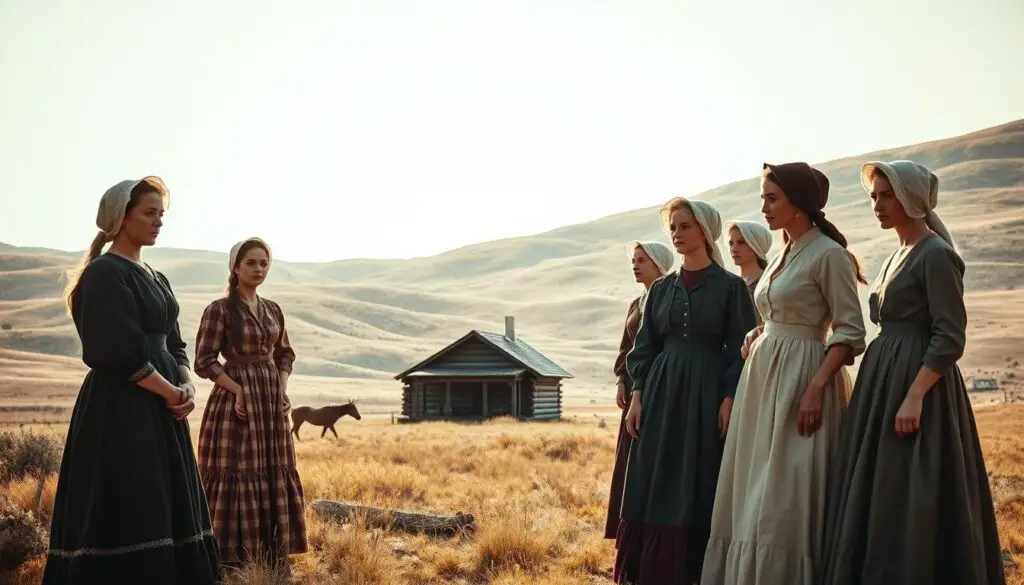
One defender wrote in 1852: “We follow divine command, not human desire.” This period saw families navigating complex relationships, with women often facing harsh scrutiny. Critics argued the system exploited participants, while adherents emphasized voluntary participation and spiritual purpose.
Government Intervention and Legal Battles
Federal lawmakers targeted the practice through legislation. The 1862 Morrill Act outlawed bigamy in U.S. territories, sparking decades of legal clashes. Key cases like Reynolds v. United States (1879) tested religious freedom boundaries, with the Supreme Court ruling against polygamy.
Three major impacts emerged from these battles:
- Confiscation of church properties
- Exclusion of polygamists from voting rights
- Mandated abandonment of the practice for statehood
By 1890, leadership officially discontinued the practice, though some splinter groups persisted. This pivot allowed smoother integration into national political systems while preserving core religious identity. The legacy of this period continues influencing discussions about religious liberty and family structures today.
Legal Battles and the Road to Utah Statehood
For decades, territorial status kept the region in political limbo. The federal government clashed with local leadership over two main issues: marriage practices and self-governance. These conflicts delayed recognition for nearly 50 years, testing both sides’ willingness to adapt.
Federal Pressures and Shifting Policies
President James Buchanan took drastic action in 1857, sending troops to install non-local officials. This “Utah War” nearly sparked violence but ended through negotiation. Over time, three key laws reshaped the landscape:
- The Morrill Act (1862) banning plural marriages
- The Edmunds Act (1882) barring polygamists from voting
- The Edmunds-Tucker Act (1887) seizing church properties
Wilford Woodruff, then leading the LDS Church, faced a critical choice. His 1890 manifesto abandoning polygamy marked a turning point. “We must submit to the law,” he declared, paving the way for dialogue.
| Year | Event | Outcome |
|---|---|---|
| 1862 | Morrill Act Passed | First federal anti-polygamy law |
| 1887 | Edmunds-Tucker Act | Church assets forfeited |
| 1890 | Woodruff’s Manifesto | Policy reversal announced |
| 1896 | Statehood Achieved | Full U.S. integration |
These compromises allowed the territory to become the 45th state after 46 years of petitions. Legal reforms demonstrated growing alignment with national norms while preserving cultural identity.
Influence of the Pioneers on Modern Utah Society
Foundational values from the 19th century continue shaping daily life across the Mountain West. Early settlers’ emphasis on cooperation and resourcefulness laid groundwork for thriving communities. Their legacy lives through institutions that blend tradition with innovation.
Cultural and Economic Contributions
The spirit of collective effort remains visible in local traditions. Annual festivals celebrate harvests much like early members did, with neighbors sharing food and skills. Schools founded by pioneers still operate, teaching practical arts alongside modern curricula.
Economic power stems from community-focused models. Credit unions and agricultural co-ops trace their roots to shared resource systems. One resident notes: “We invest in each other—that’s how our grandparents built this place.”
Shared values influence daily interactions. Volunteering rates rank among the nation’s highest, reflecting pioneer-era mutual aid principles. Local governments prioritize green spaces, continuing early land stewardship practices.
Historic irrigation networks now support urban gardens. These systems, once vital for survival, today foster sustainability. Public art installations often depict pioneer journeys, keeping their stories alive.
From policy-making to neighborhood projects, the pioneer ethos guides progress. Their blend of vision and pragmatism created a template for balancing growth with heritage—a model still shaping the region’s identity.
Mormon Church Legacy and Continuing Traditions
Balancing centuries-old traditions with contemporary needs remains a defining challenge for religious institutions. The church navigates this balance through thoughtful evolution, preserving its spiritual core while addressing modern realities.
Modern Adaptations of Ancient Beliefs
Recent initiatives highlight strategic shifts in public engagement. Updated style guides emphasize using “latter-day saints” as a preferred term, reinforcing continuity with early teachings. Outreach programs now partner with global charities, demonstrating faith through action.
Historical practices find new expressions today. Sacred gatherings once held in remote locations now stream worldwide. A church spokesperson notes: “Our doctrines remain fixed, but how we share them evolves with technology.”
| Tradition | Modern Adaptation | Impact |
|---|---|---|
| Communal Worship | Hybrid in-person/virtual services | Global participation |
| Missionary Work | Social media campaigns | Youth engagement doubled |
| Scripture Study | Interactive mobile apps | Daily usage up 40% |
The church actively addresses past controversies through transparency. Historical essays published today provide context about earlier practices, fostering understanding. This approach maintains doctrinal integrity while building bridges with broader society.
Cultural integration shines through local initiatives. Food drives blend latter-day values with community needs. Holiday events now include interfaith dialogues, reflecting America’s diverse spiritual landscape.
Exploring Utah’s Historic Landmarks
Walking through Salt Lake City feels like stepping into a living museum of resilience and vision. Every corner tells stories through stone and glass, celebrating a community’s journey from wilderness to thriving urban center. These landmarks stand as silent teachers, bridging past struggles with modern identity.
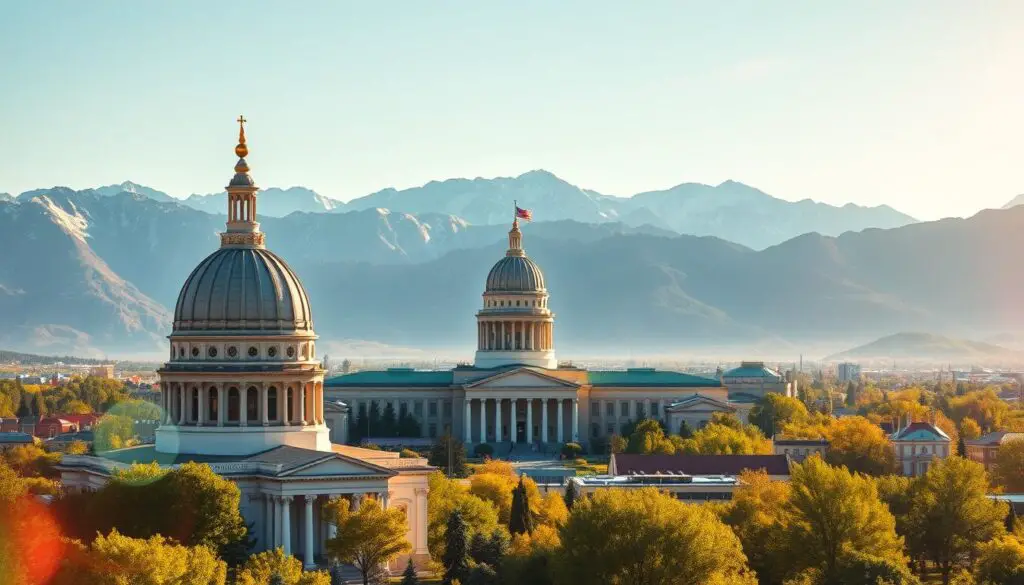
Salt Lake City Icons and Monuments
At the heart of the city, Temple Square’s granite walls showcase meticulous craftsmanship. Its six-spire design became a blueprint for regional architecture. Nearby, the Tabernacle’s domed roof—built without nails—still hosts world-class choirs, proving form and function can harmonize.
The Beehive House symbolizes industriousness, its namesake carving reminding visitors of collective effort. One tour guide shares: “This place wasn’t just a home—it was a workshop for community solutions.” Further east, the Brigham Young Monument points skyward, honoring leadership that shaped the lake city’s grid-like streets.
| Landmark | Architectural Style | Cultural Significance |
|---|---|---|
| Temple Square | Neoclassical | Spiritual and administrative core |
| Tabernacle | Pioneer Gothic | Acoustic innovation center |
| Beehive House | Federal Style | Symbol of cooperative living |
These sites anchor the city’s identity, drawing over 5 million annual visitors. They reflect how shared purpose transformed a desert valley into a crossroads of culture and faith. From pioneer-era ingenuity to modern preservation efforts, Salt Lake City’s landmarks remain touchstones for unity and progress.
Mormon Contributions to American Westward Expansion
The 19th-century expansion of America’s frontier found unexpected allies in organized groups shaping the landscape through faith and innovation. These pioneers transformed barren regions into connected communities, creating infrastructure that supported national growth. Their efforts became a hidden engine driving settlement across the West.
Three revolutionary practices defined their approach:
- Grid-based town planning enabling rapid development
- Shared irrigation systems maximizing limited water
- Cooperative trade networks linking remote settlements
A settler’s 1862 letter reveals their mindset: “We built roads before homes—knowing trails would bind us to the nation.” This foresight helped establish supply routes used by thousands of non-affiliated migrants throughout the century.
| Innovation | Local Impact | National Influence |
|---|---|---|
| Irrigation Canals | Made desert farming viable | Inspired federal reclamation projects |
| Cooperative Economics | Prevented resource hoarding | Shaped agricultural co-op models |
| Education Systems | Taught practical skills | Pioneered rural school standards |
Their trade networks stretched from California’s ports to Missouri’s markets. By establishing waystations along key trails, they boosted commerce for all travelers. These hubs later evolved into thriving cities like Denver and Las Vegas.
Cultural contributions proved equally vital. Music festivals and harvest celebrations became tools for cross-community bonding. Shared barn raisings and quilting bees inspired similar traditions among other frontier groups.
Today, their lasting 19th-century contributions stand as testament to collaborative progress. From water management to urban design, these pioneers helped write a chapter in America’s story that continues to inspire.
Comparative Perspectives: Mormon and American Religious History
Religious movements often mirror broader cultural patterns while carving unique identities. This faith community’s journey reveals both alignment with national trends and distinctive approaches to social organization. Let’s explore how their path compares to other American religious traditions.
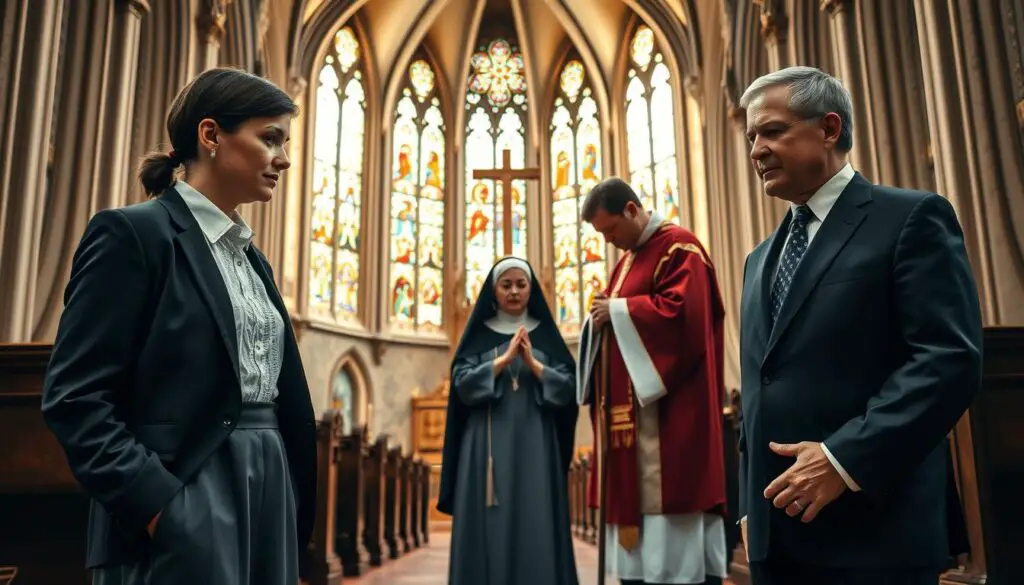
Shared Foundations, Different Expressions
Early gender roles showed surprising parallels and contrasts. Like many 19th-century groups, men frequently held leadership positions. However, women gained voting rights in church matters decades before national suffrage—a radical departure from mainstream norms.
Organizational structures shared features with other faiths:
- Hierarchical leadership resembling Catholic dioceses
- Lay clergy models similar to Protestant denominations
- Communal welfare systems mirroring Shaker practices
One 1880 journal entry notes: “Our sisters managed storehouses while brethren preached—both labored as equals in God’s eyes.” This balance of traditional roles with progressive elements created a unique social dynamic.
| Practice | Similarities | Differences |
|---|---|---|
| Leadership | Male-dominated structures | Women’s auxiliary organizations held real authority |
| Education | Sunday school systems | Early emphasis on women’s higher education |
| Community Support | Charitable outreach | Formalized welfare programs predating New Deal |
Modern adaptations show converging trends. Women now lead national committees, aligning with broader religious movements. Men increasingly share domestic duties, reflecting societal shifts. These changes demonstrate how faith traditions evolve while maintaining core identity.
Future Reflections on Mormon Utah History
Standing in the shadow of snow-capped peaks, modern communities inherit more than land—they carry forward a blueprint for collective resilience. The early settlers’ journey offers timeless lessons for tackling today’s challenges, from climate adaptation to social cohesion.
Enduring Wisdom for Tomorrow
Between 1847 and 1869, over 70,000 pioneers transformed the Great Basin. Their numbers grew through careful planning—each wagon company carried seeds for 5 acres of crops. This foresight created food security for 500% population growth within 25 years.
Three key principles remain vital:
- Resource sharing during scarcity
- Adaptive problem-solving in crises
- Long-term investment in community assets
| Era | Challenge | Modern Parallel |
|---|---|---|
| 1850s | Irrigating deserts | Water conservation tech |
| 1870s | Building trade routes | Renewable energy grids |
| 2020s | Preserving values | Digital community hubs |
Current initiatives mirror pioneer ingenuity. Urban farms now use 19th-century irrigation methods to combat food deserts. Neighborhood councils revive cooperative decision-making models from 150 years ago.
The past isn’t just preserved—it’s a compass. As one historian notes: “Their greatest gift wasn’t what they built, but how they taught us to build together.” This legacy challenges each generation to create solutions as bold as their ancestors’ covered wagons.
Conclusion
Guided by steadfast leaders like Brigham Young and later church presidents, pioneers transformed adversity into enduring achievement. Their journey—from sacred revelations to sustainable settlements—showcases how vision and adaptability build legacies.
Key moments echo through time: bold migrations, innovative water systems, and cultural traditions born from unity. Modern presidents continue this ethos, balancing heritage with contemporary needs. Historic trails and festivals invite exploration of these interconnected stories.
Resilience remains the cornerstone. Early cooperation forged institutions that still thrive today, proving shared goals overcome obstacles. Visitors walking temple grounds or studying irrigation maps witness living history firsthand.
This narrative isn’t just about the past—it’s a roadmap for future collaboration. Discover how faith, leadership, and community shape progress. Let their journey inspire your own.
FAQ
Why did early Church members leave New York?
Seeking refuge from persecution, followers of Joseph Smith moved west to establish communities where they could freely practice their beliefs. Conflicts in Missouri and Illinois eventually pushed them toward the Rocky Mountains.
How did Brigham Young shape settlement in the Great Salt Lake Valley?
After Joseph Smith’s death, Brigham Young led the westward exodus, selecting the valley for its isolation and natural resources. His leadership ensured survival through organized planning, irrigation systems, and communal cooperation.
What made handcart companies unique during migration?
Handcarts provided a low-cost option for families without wagons. Though some groups faced harsh conditions, these companies exemplified resilience and collective effort, becoming a symbol of pioneer determination.
Why did polygamy cause tension with the federal government?
The practice conflicted with U.S. laws, leading to raids, arrests, and denied statehood. In 1890, President Wilford Woodruff issued the Manifesto, ending plural marriage to comply with federal demands and pave the way for Utah’s statehood.
What delayed Utah’s admission to the United States?
Disputes over polygamy and the Church’s political influence stalled statehood for decades. After banning the practice and adopting a secular government, Utah became the 45th state in 1896 under President Cleveland.
Which landmarks reflect Salt Lake City’s pioneer heritage?
Temple Square, the Tabernacle, and This Is the Place Heritage Park honor early settlers. These sites showcase architectural innovation and cultural traditions tied to the region’s founding.
How do pioneer values influence Utah today?
Community-focused ideals, education, and thriftiness remain central. Annual Pioneer Day celebrations and family history preservation highlight the enduring legacy of self-reliance and unity.
How has the Church adapted its practices over time?
While core doctrines like service and revelation persist, shifts include ending polygamy, expanding global outreach, and emphasizing interfaith collaboration. Modern tools like genealogy databases also connect members to their past.
